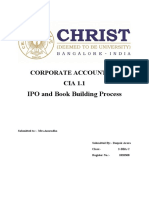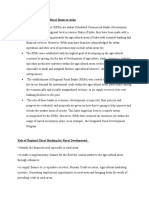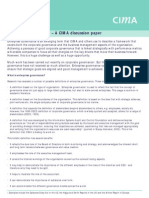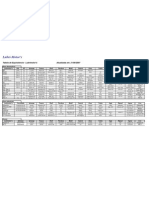2) Short Notes: A) Forms of Dividend
2) Short Notes: A) Forms of Dividend
Uploaded by
Tarunvir KukrejaCopyright:
Available Formats
2) Short Notes: A) Forms of Dividend
2) Short Notes: A) Forms of Dividend
Uploaded by
Tarunvir KukrejaOriginal Title
Copyright
Available Formats
Share this document
Did you find this document useful?
Is this content inappropriate?
Copyright:
Available Formats
2) Short Notes: A) Forms of Dividend
2) Short Notes: A) Forms of Dividend
Uploaded by
Tarunvir KukrejaCopyright:
Available Formats
2) Short notes
a) Forms of dividend
Cash Dividend: Cash dividend is the most popular form of dividend payout. In this,
company issues the dividend to all shareholders where the money is deposited in the
bank accounts of shareholders as per the holdings of the investors. Usually there is a
predefined process for the dividend declaration.
Stock dividend: If any company issues additional shares to common shareholders
without any consideration then the action becomes stock dividend. If the company
issues less than 25% of the previously issued stocks then it will be treated as the stock
dividend. If the issuance of new shares is more than 25% of the last issue shares then
it is treated as the stocksplit.
Property dividend: Any company can issue any non-monetary dividend to its
shareholders. The issued property dividend would be recorded against the current
market price of the asset distributed. As the market price of the asset is expected to be
either above or below the book value therefore it would either incur profit or loss and
accordingly would be entered in the books. This interpretation of the distributed asset
may force businesses to intentionally issue the property dividend to manipulate the
taxable income.
Scrip dividend: When any company doesnt have enough funds to pay dividend then
it may choose to pay dividend in the form of promissory note to pay the shareholders
at a later date. This essentially creates a note payable.
Liquidating dividend: When the board of the company thinks of returning the
original capital invested by the shareholders then it is known as the liquidating
dividend. This may happen due to the fact the company intends to wrap up the
business.
b) Bonus issue
A bonus issue of shares is stock issued by a company in lieu of cash dividends.
Shareholders can sell the shares to meet their liquidity needs.
Bonus shares increase a company's share capital but not its net assets.
c) Stock split
A stock split is a corporate action in which a company increases the number of its
outstanding shares by issuing more shares to current shareholders.
The primary motive of a stock split is to make shares seem more affordable to small
investors.
Although the number of outstanding shares increases and the price per share
decreases, the market capitalization (and the value of the company) does not change.
d) Buy back of shares
A buyback occurs when the issuing company pays shareholders the market value per
share and re-absorbs that portion of its ownership that was previously distributed
among public and private investors.
With stock buybacks, aka share buybacks, the company can purchase the stock on the
open market or from its shareholders directly. In recent decades, share buybacks have
overtaken dividends as a preferred way to return cash to shareholders.
Though smaller companies may choose to exercise buybacks, blue-chip companies
are much more likely to do so because of the cost involved.
You might also like
- Brief Exercise 1.4: Kimmel, Weygandt, Kieso, Trenholm, Irvine, Burnley Financial Accounting, Eighth Canadian EditionDocument6 pagesBrief Exercise 1.4: Kimmel, Weygandt, Kieso, Trenholm, Irvine, Burnley Financial Accounting, Eighth Canadian EditionTowkirNo ratings yet
- Dividend Policy of Reliance Industries SwatiDocument24 pagesDividend Policy of Reliance Industries SwatiYashasvi KothariNo ratings yet
- FORMSOFDIVIDENDDocument2 pagesFORMSOFDIVIDENDshobhadutta0909No ratings yet
- FORMSOFDIVIDENDDocument2 pagesFORMSOFDIVIDENDshweta jaiswalNo ratings yet
- FM Dividend DecisionsDocument7 pagesFM Dividend DecisionsSuraj AgarwalNo ratings yet
- Canadian Securities 1 Week 8 Equity Securities - Common and Preference SharesDocument14 pagesCanadian Securities 1 Week 8 Equity Securities - Common and Preference Sharesvandana.devakumarNo ratings yet
- Dividend Assignment 1212Document3 pagesDividend Assignment 1212yatin rajputNo ratings yet
- CH 5 Dividend Policy and TheoryDocument10 pagesCH 5 Dividend Policy and Theoryhailegebreselassie24No ratings yet
- Accountancy Theory ExtraDocument2 pagesAccountancy Theory Extrajimmyadamskl69No ratings yet
- Corporate Accounting (Bcom) - Module IDocument7 pagesCorporate Accounting (Bcom) - Module IChinchuNo ratings yet
- 3 Sem Coporate Accounting B.com UocBcomStudyMaterial - BotDocument13 pages3 Sem Coporate Accounting B.com UocBcomStudyMaterial - Botfadilar7306No ratings yet
- Fa Unit 4Document13 pagesFa Unit 4VTNo ratings yet
- Module 5Document4 pagesModule 5ErwinNo ratings yet
- Corporate Accounting 1: III Semester BBADocument57 pagesCorporate Accounting 1: III Semester BBAAR Ananth Rohith BhatNo ratings yet
- Dividend Policy & Long-Term Financing Overview: Session 10Document17 pagesDividend Policy & Long-Term Financing Overview: Session 10May CancinoNo ratings yet
- Unit 6Document39 pagesUnit 6Hemanta PahariNo ratings yet
- Dividend PolicyDocument29 pagesDividend Policyaksharmohta17No ratings yet
- Corporate ActionsDocument10 pagesCorporate Actionsdhanraj patadiaNo ratings yet
- FM II Chapter 1Document12 pagesFM II Chapter 1Addisu TadesseNo ratings yet
- Ca NoteDocument16 pagesCa Notesitharavp00No ratings yet
- Dividend - Wikipedia, The Free EncyclopediaDocument6 pagesDividend - Wikipedia, The Free Encyclopediaapi-3763198No ratings yet
- Corporate Finance - Aaqib NazimuddinDocument10 pagesCorporate Finance - Aaqib NazimuddinAaqib ChaturbhaiNo ratings yet
- Sources of FinanceDocument6 pagesSources of FinanceNeesha NazNo ratings yet
- Share: by Aju K Raju Mba Ii MiimDocument13 pagesShare: by Aju K Raju Mba Ii MiimAju K Raju100% (1)
- Fin 501 Payout PolicyDocument14 pagesFin 501 Payout Policyovi_hassan74No ratings yet
- Corporate Accounting Theory For First Unit-2Document9 pagesCorporate Accounting Theory For First Unit-2Rigved PrasadNo ratings yet
- Corp Acc - by JuRa'Z - BComDocument16 pagesCorp Acc - by JuRa'Z - BComABDUL GAFOORNo ratings yet
- PDF 1 - DividendDocument11 pagesPDF 1 - Dividendrahul bhilalaNo ratings yet
- Dividend Decisions: TheoryDocument24 pagesDividend Decisions: TheoryAvimanyu AdhikariNo ratings yet
- Resume Chapter 17 DividendDocument3 pagesResume Chapter 17 DividendvirginelkaNo ratings yet
- Dividend PolicyDocument22 pagesDividend PolicyKALASH INTERNATIONALNo ratings yet
- AIFA UNIT-3 NOTES BbaDocument17 pagesAIFA UNIT-3 NOTES Bbaashyagami974No ratings yet
- Dividends & Dividend Policies - Set 1Document9 pagesDividends & Dividend Policies - Set 1Tushant bandhuNo ratings yet
- Financial Accounting - Module 4Document24 pagesFinancial Accounting - Module 4Ethan Mumba MapaloNo ratings yet
- Definition of Dividend Capitalization ModelDocument4 pagesDefinition of Dividend Capitalization Modelnuk.2021018028No ratings yet
- Sourcing Money May Be Done For A Variety of ReasonsDocument24 pagesSourcing Money May Be Done For A Variety of ReasonsFelix Amirth RajNo ratings yet
- Topic 3 - Stock ValuationDocument39 pagesTopic 3 - Stock ValuationSin Yee HohNo ratings yet
- Dividend: HistoryDocument20 pagesDividend: Historyanup bhattNo ratings yet
- Corporate Dividend PolicyDocument187 pagesCorporate Dividend Policyrohan2788100% (1)
- Module 12 Shareholders EquityDocument8 pagesModule 12 Shareholders EquityayieezaalondraNo ratings yet
- 74780bos60495 cp8Document52 pages74780bos60495 cp8consistencytusharNo ratings yet
- Limited CompaniesDocument4 pagesLimited CompaniesSukhmani KaurNo ratings yet
- Module 4-CoC-1Document13 pagesModule 4-CoC-1Abida RiazNo ratings yet
- Tybcom - Share NotesDocument749 pagesTybcom - Share NotesManojj21No ratings yet
- Cac Bonus Share 22-1Document12 pagesCac Bonus Share 22-1gauravjaj4No ratings yet
- 1 - Distribution To Shareholders - Dividends and Share Repurchases PDFDocument4 pages1 - Distribution To Shareholders - Dividends and Share Repurchases PDFhenryNo ratings yet
- Dividend PolicyDocument8 pagesDividend PolicyScribdTranslationsNo ratings yet
- Module 21-Shareholders-EquityDocument12 pagesModule 21-Shareholders-EquityJehPoy100% (1)
- Notes To SharesDocument3 pagesNotes To SharesKartikay UpadhyayNo ratings yet
- Corporate Finance - Dividend PolicyDocument8 pagesCorporate Finance - Dividend PolicyYoussef AlyNo ratings yet
- PM AssignmentDocument22 pagesPM AssignmentEmuyeNo ratings yet
- Chapter - 2 Conceptual Framework of DividendDocument36 pagesChapter - 2 Conceptual Framework of DividendMadhavasadasivan PothiyilNo ratings yet
- Account II Old Is GoldDocument28 pagesAccount II Old Is Goldsamirkarkee2No ratings yet
- Financial Management Ii: Chapter 1dividend Policy and TheoryDocument54 pagesFinancial Management Ii: Chapter 1dividend Policy and TheoryhabtamuNo ratings yet
- Chapter 22 Share CapitalDocument25 pagesChapter 22 Share CapitalHammad AhmadNo ratings yet
- FM H Chapter 1 0 2Document23 pagesFM H Chapter 1 0 2MOLALIGNNo ratings yet
- Corporate AccountingDocument16 pagesCorporate AccountingshakuttiNo ratings yet
- Chapter 7 - Homework & Solution: Answers To QuestionsDocument15 pagesChapter 7 - Homework & Solution: Answers To QuestionsSumera Sarwar100% (1)
- Dividend Investing for Beginners & DummiesFrom EverandDividend Investing for Beginners & DummiesRating: 5 out of 5 stars5/5 (2)
- Dividend Investing: Passive Income and Growth Investing for BeginnersFrom EverandDividend Investing: Passive Income and Growth Investing for BeginnersNo ratings yet
- Dividend Growth Investing: A Step-by-Step Guide to Building a Dividend Portfolio for Early RetirementFrom EverandDividend Growth Investing: A Step-by-Step Guide to Building a Dividend Portfolio for Early RetirementNo ratings yet
- BV Async AssignmentDocument2 pagesBV Async AssignmentTarunvir KukrejaNo ratings yet
- BANK MANAGEMENT Role of NpaDocument2 pagesBANK MANAGEMENT Role of NpaTarunvir KukrejaNo ratings yet
- IPO and Book Building Process: Corporate Accounting CIA 1.1Document11 pagesIPO and Book Building Process: Corporate Accounting CIA 1.1Tarunvir KukrejaNo ratings yet
- Strategic Financial Management: Complete The Crossword Puzzle BelowDocument2 pagesStrategic Financial Management: Complete The Crossword Puzzle BelowTarunvir KukrejaNo ratings yet
- Name: CHAHAT GUPTA, Reg. No: 1820338, Is A Bonafide Student of Our University andDocument1 pageName: CHAHAT GUPTA, Reg. No: 1820338, Is A Bonafide Student of Our University andTarunvir KukrejaNo ratings yet
- Strategic Financial Management: Complete The Crossword Puzzle BelowDocument2 pagesStrategic Financial Management: Complete The Crossword Puzzle BelowTarunvir KukrejaNo ratings yet
- Article Review of Business Valuation and Economic Loss AnalysisDocument3 pagesArticle Review of Business Valuation and Economic Loss AnalysisTarunvir KukrejaNo ratings yet
- Video Review Valuing Markets and Young CompaniesDocument3 pagesVideo Review Valuing Markets and Young CompaniesTarunvir KukrejaNo ratings yet
- BV Video HarshDocument3 pagesBV Video HarshTarunvir KukrejaNo ratings yet
- Incidence and Residence ProblemsDocument9 pagesIncidence and Residence ProblemsTarunvir KukrejaNo ratings yet
- Tarunvir Kukreja: EducationDocument1 pageTarunvir Kukreja: EducationTarunvir KukrejaNo ratings yet
- Asian Paints Strategic AnalysisDocument3 pagesAsian Paints Strategic AnalysisTarunvir KukrejaNo ratings yet
- Additional English CIA Sarah Fayyaz 1620555 I Speak Up Bluntly - SukirtharaniDocument1 pageAdditional English CIA Sarah Fayyaz 1620555 I Speak Up Bluntly - SukirtharaniTarunvir KukrejaNo ratings yet
- Programs and PerformersDocument4 pagesPrograms and PerformersTarunvir KukrejaNo ratings yet
- The Reserve Bank of India (RBI) Is India's Financial Institution, Which Controls TheDocument2 pagesThe Reserve Bank of India (RBI) Is India's Financial Institution, Which Controls TheTarunvir KukrejaNo ratings yet
- Development of Regional Rural Banks in IndiaDocument2 pagesDevelopment of Regional Rural Banks in IndiaTarunvir KukrejaNo ratings yet
- Tata Group: Strategic Management (1820328)Document3 pagesTata Group: Strategic Management (1820328)Tarunvir KukrejaNo ratings yet
- Sarthak Sahewala 1820329: The Roles and Responsibilities of RBI AreDocument1 pageSarthak Sahewala 1820329: The Roles and Responsibilities of RBI AreTarunvir KukrejaNo ratings yet
- Business Valuation Case StudyDocument3 pagesBusiness Valuation Case StudyTarunvir KukrejaNo ratings yet
- Delhi Public School, Jammu List of Teaching Staff (2019-20)Document9 pagesDelhi Public School, Jammu List of Teaching Staff (2019-20)Tarunvir KukrejaNo ratings yet
- Loan Waiver Vs Loan Write-Off: The Effects of Loan Waiver Schemes On Public Finance and EcoDocument1 pageLoan Waiver Vs Loan Write-Off: The Effects of Loan Waiver Schemes On Public Finance and EcoTarunvir KukrejaNo ratings yet
- Chapter 1 Afar (Bus Com)Document24 pagesChapter 1 Afar (Bus Com)jajajaredredNo ratings yet
- Final Exams PArCOr 2020Document4 pagesFinal Exams PArCOr 2020John Alfred CastinoNo ratings yet
- Chapter05 - Business Ownership PDFDocument29 pagesChapter05 - Business Ownership PDFAbdullahNo ratings yet
- GoBuyside 2016 United States Compensation StudyDocument5 pagesGoBuyside 2016 United States Compensation StudyBen HollowayNo ratings yet
- Muthoot Finance Completes Acquisition of Muthoot Insurance Brokers PVT Limited (Company Update)Document2 pagesMuthoot Finance Completes Acquisition of Muthoot Insurance Brokers PVT Limited (Company Update)Shyam SunderNo ratings yet
- Why Ceos Fail PDFDocument7 pagesWhy Ceos Fail PDFPrince Charles MoyoNo ratings yet
- Fundamental Accounting Principles: 17 Edition Larson Wild ChiappettaDocument42 pagesFundamental Accounting Principles: 17 Edition Larson Wild ChiappettaAnbuoli ParthasarathyNo ratings yet
- Information Sheet: Cyprus CompaniesDocument3 pagesInformation Sheet: Cyprus CompanieskalinovskayaNo ratings yet
- December 2020 Review: Euler Hermes Country Risk RatingsDocument5 pagesDecember 2020 Review: Euler Hermes Country Risk RatingsLFNo ratings yet
- What's in What's Out AMC Holdings: Mutual FundsDocument292 pagesWhat's in What's Out AMC Holdings: Mutual FundsRudra GoudNo ratings yet
- Dabur Annual RepDocument188 pagesDabur Annual RepsameerkmrNo ratings yet
- Forms of Business Organization - Tagalog JhsDocument13 pagesForms of Business Organization - Tagalog JhsLily Mar Vinluan100% (1)
- Initial Public Offer (Ipo)Document30 pagesInitial Public Offer (Ipo)Shruti AshokNo ratings yet
- AFAR ReviewDocument6 pagesAFAR ReviewDenise Jane RoqueNo ratings yet
- Decisions Penned by Justice Prisbeterio Velasco.Document17 pagesDecisions Penned by Justice Prisbeterio Velasco.Xing Keet LuNo ratings yet
- Kertas Kerja Konsolidasi Pada Tanggal Akuisisi - Id.enDocument17 pagesKertas Kerja Konsolidasi Pada Tanggal Akuisisi - Id.enHana Cahya NingrumNo ratings yet
- Quiz Integ BusCom ForExDocument7 pagesQuiz Integ BusCom ForExPrankyJellyNo ratings yet
- Corporate Law Questions and Case LawsDocument12 pagesCorporate Law Questions and Case LawsPraveen Kumar KokkantiNo ratings yet
- 2020-01, Ambit Capital - When Accounting PredictedDocument62 pages2020-01, Ambit Capital - When Accounting PredictedKarthikNo ratings yet
- 2020 Registered Insurance Intermediaries As at 7th July 2020-MergedDocument192 pages2020 Registered Insurance Intermediaries As at 7th July 2020-MergedJohn GogoNo ratings yet
- Mx-Mex-Fmx: Express DomesticDocument6 pagesMx-Mex-Fmx: Express DomesticSofo Zaid Olguin PNo ratings yet
- Dokumen - Tips Ch03test Bank Jeter Chapter 3Document18 pagesDokumen - Tips Ch03test Bank Jeter Chapter 3Evelyn Purnama SariNo ratings yet
- Ove@du - Edu: Corporate Governance Principles and SustainabilityDocument14 pagesOve@du - Edu: Corporate Governance Principles and SustainabilityauliaNo ratings yet
- Accounting For Business Combination ReviewerDocument21 pagesAccounting For Business Combination ReviewerJoyce MacatangayNo ratings yet
- EPS and DPSDocument3 pagesEPS and DPSJaehyunnssNo ratings yet
- Accounting For CorporationDocument59 pagesAccounting For CorporationFawad Ali shaikhNo ratings yet
- Enterprise Governance - A CIMA Discussion PaperDocument5 pagesEnterprise Governance - A CIMA Discussion PaperAdmire MamvuraNo ratings yet
- Cme 2018 PDFDocument134 pagesCme 2018 PDFمحمد الياميNo ratings yet
- Tabela LubrimotorsDocument1 pageTabela LubrimotorsjaburecaNo ratings yet














































































































